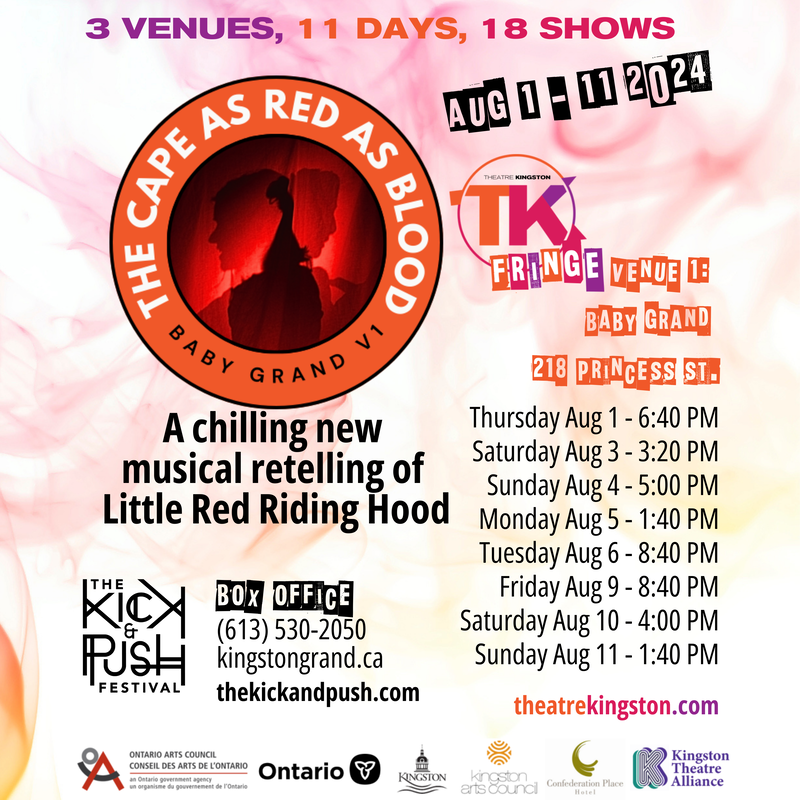Little Red Riding Hood Bares her Teeth in ‘The Cape as Red as Blood’

Listen to the wind whisper the story of The Cape as Red as Blood—a loose retelling of the Little Red Riding Hood folktale as a folk musical. Written by Kathleen Greening, this is a contemporary version of the story with a powerfully feminine vibe—soft and caring, but not weak by any means, and not to be underestimated. The five storytellers—Nightingale (Syd Chinnick), Crow (Meg Gibson), Phoenix (Hailey Hatfield), Bluebird (Elsa McKnight), and Canary (Elise Wight)—in the cast provide an excellent ensemble as well as distinct main characters as needed. Overall, the show is feminine and powerful, taking down sexism, gendered violence, and environmental violence all together, with a powerful iteration of Red Riding Hood fighting back.
In this version of the story, Red is raised in the woods by her grandmother, and not afraid of the forest in the least. What she really fears is the loss of the trees, as they are being cut down en masse by the townspeople nearby who seek wealth and prosperity through this natural resource. There is a clear environmental message here, but also the classic story of one small person standing up to a larger whole that is causing damage. The narrative is somewhat simplistic in this way, but very compelling and I was definitely rooting for Red throughout. There is also a nice twist around the figure of the Woodcutter, and Red isn’t so meek and helpless as she might appear or be portrayed as in more traditional versions.
The songs are super catchy—I want a recording of them ASAP so I can keep listening (I still find myself humming “The Wind Whispered”). They work really well with the voices of the ensemble and are often intertwined with different musical tactics like call and response. Similarly to the ways that their voices are intertwined, the costumes are all adjacent to each other—sisters, not twins. They are contemporary clothes but with a cottagecore vibe, each actor wearing some form of denim (skirt, jacket, etc.) with similarly colourful fabric patches sewn on. There are also a couple of very masculine characters (patriarchal authority figures), who are conveyed with a few choice pieces (a cane, a leather jacket, a flannel shirt). The costumes contribute nicely to the cohesiveness of the performance and songs. Even more charmingly, the performers use sock puppetry to portray the different townsfolk, who give their (mostly unwanted or selfish) opinions on Red and the forest as consumable.
The bare set centres around what looks to be about a 4’x6’ sheet on a frame to make a small screen, with a light behind it that could be used to create shadow puppetry and silhouettes of the performers, which allow for some very powerful moments with limited set design. There are one or two key moments where the shadows, though very effective, could have paused or had the movements drawn out a little longer for emphasis. The other main pieces are a few plinths, and piano and guitar stands for instruments, which are used interchangeably by different actors, with very smooth transitions. There is great movement from the performers across all of the stage and on top of the plinths, and the songs of course include some great dance sequences, again emphasizing the cohesiveness of the ensemble.
This play shows that Red Riding Hood, and even remakes of Red Riding Hood, aren’t blasé or overdone. There’s still rich content to work out from the tale, especially with the added environmental message in this case. In particular, younger generations (hey, Gen Z) can adapt the story in innovative ways (with really catchy music), while using folk inspiration and traditional devices like puppetry. The show has overall feel-good vibes, and more than that, its innovation made me feel hopeful about the future in general (not an easy feat!).
‘The Cape as Red as Blood’ played at the Grand Theatre in TK Fringe as part of the 2024 Kick & Push Festival. For more information, click here.
